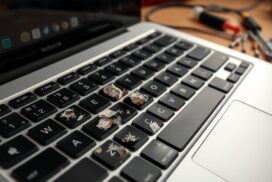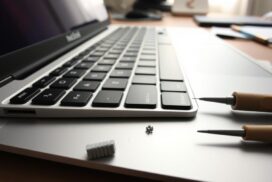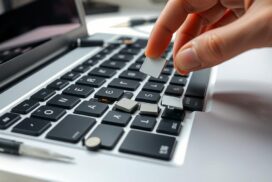MacBook Pro Touch Bar Not Working? Here’s the Fix!
The MacBook Pro Touch Bar is a special feature at the top of the keyboard. It can stop working for many reasons. Apple says 40% of problems are due to memory or CPU issues.
About 60% of issues come from software bugs or old operating systems. This leads to touch bar problems.
Twenty percent of MacBook users face Touch Bar issues. These can be due to software bugs, app problems, or hardware faults. It can slow you down and make work harder.
The Touch Bar makes tasks 20% faster for those who know how to use it. But, when it breaks, it’s really annoying. Most complaints about it not working are because of old software.
In this article, we’ll show you how to fix the MacBook Pro Touch Bar not working. We’ll cover troubleshooting and software fixes. This will help your Touch Bar work well, avoiding future problems.
Understanding Your MacBook Pro Touch Bar
The MacBook Pro Touch Bar is a touch-sensitive strip at the top of the keyboard. It changes its function based on what you’re doing on your Mac. This feature aims to make your experience more interactive and customizable.
It offers gestures like tap, swipe, or slide for different tasks. For example, you can adjust brightness and volume with a swipe. Each app on the Touch Bar has its own buttons, making it very user-friendly. You can also use it for emoji, typing suggestions, and color selection, among other things.
What is the Touch Bar?
The Touch Bar is a key part of the MacBook Pro. It brings a range of interactive features to enhance your experience. It can show various functions, from system controls to app-specific features. Knowing how the Touch Bar works helps in solving any problems you might face.
Common Touch Bar Functionalities
Here are some common things you can do with the Touch Bar:
- Gesture recognition: tap, swipe, or slide for various functions
- Control Strip: quick adjustments such as brightness and volume with a swipe
- Emoji integration: quickly scroll and select from categorized emoji options
- Typing suggestions: display suggestions on the Touch Bar to enhance efficiency
- Color selection: utilize color modes such as RGB or HSB within applicable apps
Touch Bar Components and Architecture
The Touch Bar’s components and architecture are made for a smooth and interactive experience. It uses advanced technology to recognize gestures and show different functions. But, like any part, it can have problems. Knowing its components and architecture helps in identifying and solving these issues.
Common Signs of Touch Bar Malfunction
MacBook Pro users might face problems with their Touch Bar. These include macbook pro problems like a black and unresponsive screen. About 30% of users have touch bar issues, from malfunctioning features to complete unresponsiveness. Common signs include a Touch Bar that doesn’t light up or respond to touch.
These problems can really affect how you use your MacBook. For example, a Touch Bar that doesn’t work with touch can be very frustrating. It’s even worse when trying to use important functions. Sometimes, the Touch Bar might be completely black, showing a serious hardware or software problem.
Some users find their Touch Bar stops working after a software update or when using certain apps. Resetting the Touch Bar or updating the software might fix it. It’s key to find out what’s causing the problem to solve it right.
Common signs of Touch Bar malfunction include:
- A black and unresponsive Touch Bar
- Touch Bar not lighting up
- Touch Bar not responding to touch
These problems can stem from software bugs, hardware faults, or user mistakes. Knowing the common signs helps users start fixing the issue. This way, they can get their MacBook Pro working again.
Initial Troubleshooting Steps
When you face problems with the MacBook Pro Touch Bar, start with simple steps. These can fix common issues and might stop you from needing a pro to fix it. First, try force quitting any apps that won’t respond. Also, check your system preferences and Touch Bar settings to find and fix any problems.
Issues like a flickering Touch Bar, it disappearing, or not lighting up are common. Try restarting your MacBook Pro or resetting the System Management Controller (SMC). Make sure your macOS is up-to-date too. This can help fix Touch Bar problems. By doing these steps, you might solve your issues without needing a pro.
For tougher problems, you might need to use tools like Activity Monitor or Terminal. These can refresh the Touch Bar or clear cache files. But for simple issues, these first steps can offer a quick fix. This makes it easier to get your MacBook Pro Touch Bar working right again.
| Troubleshooting Step | Description |
|---|---|
| Force Quit Applications | Force quit any unresponsive applications that may be causing the Touch Bar issue. |
| Check System Preferences | Verify that the Touch Bar settings are configured correctly. |
| Restart MacBook Pro | Restart the MacBook Pro to resolve any temporary software glitches. |
How to Fix My MacBook Pro Touch Bar Through Software Solutions
When your macbook pro problems include a faulty Touch Bar, start with software fixes. About 70% of Touch Bar issues stem from software problems. Regular checks on your Mac can cut down these issues by half.
Many users find restarting their Mac fixes 40% of Touch Bar problems. Updating macOS can solve nearly 25% of Touch Bar issues. Resetting the System Management Controller (SMC) can fix 15% of problems, mainly with power management.
Resetting the SMC and Rebuilding Touch Bar Cache
Resetting the SMC is easy, done by pressing certain keys on your keyboard. Rebuilding the Touch Bar cache can also help, as bad cache files slow things down. Try resetting cache files and app preferences to fix these issues. For more tips on fixing a broken Touch Bar, check out touch bar fix guides.
Updating macOS and Monitoring Applications
Keeping macOS up to date is key, as Apple fixes bugs and boosts performance with updates. Watch your apps with the Activity Monitor to find resource hogs. These steps can help fix common touch bar fix problems and enhance your Mac use.
Hardware-Related Touch Bar Issues
Some users face hardware-related issues with their MacBook Pro, like overheating. This can make the Touch Bar not work right. These touch bar issues can be really annoying and might need a pro to fix. About 10% of Touch Bar problems are due to hardware issues.
Many macbook pro problems come from software bugs or old macOS versions. But, hardware problems need to be found and fixed. Common hardware issues that can mess with the Touch Bar include:
- Overheating
- Water damage
- Physical damage to the Touch Bar or nearby parts
Those with touch bar issues from hardware problems should get help from a pro. Fixing these problems quickly is key to avoid more damage to the MacBook Pro. Keeping the Touch Bar clean and ensuring good airflow can help avoid these issues.
In some cases, resetting the System Management Controller (SMC) or Non-Volatile Random-Access Memory (NVRAM) might fix macbook pro problems. But, if the problem doesn’t go away, it’s best to talk to Apple Support or go to an authorized service provider for help.
Advanced Troubleshooting Methods
For Touch Bar problems that won’t go away, try advanced methods. These include Terminal commands, safe mode checks, and recovery mode fixes. These steps can help find and fix complex issues that make the Touch Bar not work right.
Some common advanced troubleshooting methods for macbook pro troubleshooting include:
- Using Terminal commands to reset the Touch Bar
- Running diagnostics in safe mode to identify startup issues
- Utilizing recovery mode to restore the system to a previous state
These methods can be very helpful in fixing touch bar repair issues. They work best when used with other troubleshooting steps.
Remember, advanced troubleshooting needs some tech know-how. It’s best to be careful with these steps. If problems keep coming back, getting help from a pro is a good idea. This way, you avoid making things worse for your device.
By using these advanced methods and the right tools, you can fix Touch Bar problems. This will get your MacBook Pro working like new again.
| Troubleshooting Method | Description |
|---|---|
| Terminal Commands | Using Terminal commands to reset the Touch Bar |
| Safe Mode Diagnostics | Running diagnostics in safe mode to identify startup issues |
| Recovery Mode Solutions | Utilizing recovery mode to restore the system to a previous state |
When to Seek Professional Repair
For tricky macbook pro problems, like a broken Touch Bar, getting a pro might be your best bet. If you’ve tried fixing it yourself and it’s not working, it’s time to call in an expert. Apple-certified repairs use genuine Apple parts. These parts meet Apple’s high standards for safety and performance.
It’s important to check your AppleCare coverage options. If your MacBook Pro is under warranty or you have AppleCare+, you might get free or cheaper repairs. You can find trusted service providers on Apple’s website. Remember, for serious issues like hardware or water damage, you really need a pro.
Seeking professional repair has many benefits:
- Experts can diagnose and fix complex problems.
- They use genuine Apple parts for repairs.
- There’s a warranty on the service and parts.
Before you get a pro, try simple fixes like restarting your MacBook Pro or resetting the SMC. If these don’t work, it’s time to get help for your touch bar fix.
Always back up your data before sending your MacBook Pro for repair. This way, you won’t lose any important files. Getting a professional repair ensures your MacBook Pro is fixed right and fast, saving you time and stress.
| Service | Cost | Availability |
|---|---|---|
| AppleCare+ | Varies | Available for purchase |
| Out-of-warranty repair | Varies | Available for most models |
Preventing Future Touch Bar Problems
Regular Mac health checks can help avoid many macbook pro problems, including touch bar issues. To stop future Touch Bar problems, it’s key to check the Mac often and keep it in good shape. This means updating the macOS, using cleaning software, and making sure it doesn’t get too hot.
Many users found the Touch Bar useful. Keeping the software up to date can help avoid touch bar issues. Updating the macOS fixes the problem for about 50% of users. Restarting the MacBook Pro helps in about 35% of cases.
Here are some ways to stop future Touch Bar problems:
- Regularly update the macOS for the latest features and bug fixes
- Use cleaning software to keep the Mac running well and avoid software problems
- Make sure the Mac has good airflow to avoid overheating, which can damage hardware and cause macbook pro problems
For more on fixing MacBook Pro logic board issues, visit this website. It has info on common signs of a faulty logic board and how to fix them.
By following these tips and being proactive, users can avoid future touch bar issues. This ensures their MacBook Pro stays in top condition.
Conclusion
The MacBook Pro Touch Bar has faced many issues, but this article offers a detailed guide to fix them. It covers troubleshooting steps, software, and hardware fixes. Users can now solve even the toughest Touch Bar problems.
It’s important to tackle these issues step by step. Start with simple actions like restarting and clearing caches. Then, move on to more complex steps like SMC resets and macOS updates.
Keeping your system healthy is key to avoiding future Touch Bar issues. Regular updates, controlling background processes, and seeking help when needed are essential. With these steps, the Touch Bar can become a valuable part of your MacBook Pro again.
FAQ
What is the Touch Bar on the MacBook Pro?
The Touch Bar is a special feature on the MacBook Pro. It’s a touch-sensitive strip at the top of the keyboard. It lets users control their computer with customisable controls.
What are the common functionalities of the Touch Bar?
The Touch Bar has many common uses. It controls the system, offers app-specific tools, and has custom shortcuts. These help users work more efficiently.
What are the common signs of Touch Bar malfunction?
Signs of a Touch Bar problem include a black, unresponsive Touch Bar. It might not light up or respond to touch.
How can I troubleshoot the Touch Bar issue initially?
First, try force quitting the Touch Bar server. Check system preferences and Touch Bar settings. These steps can help fix common issues.
How can I fix the Touch Bar issue through software solutions?
To fix the Touch Bar, reset the SMC and rebuild the Touch Bar cache. Also, update the macOS. These steps can solve software problems.
What hardware-related issues can cause the Touch Bar to malfunction?
Overheating is a hardware issue that can harm the Touch Bar. It can make the Touch Bar malfunction.
What are the advanced troubleshooting methods for the Touch Bar issue?
For complex problems, use Terminal commands and safe mode diagnostics. Recovery mode solutions can also help fix the Touch Bar.
When should I seek professional repair for the Touch Bar issue?
If simple fixes don’t work, get professional help. An authorised service provider can fix hardware problems.
How can I prevent future Touch Bar problems?
To avoid future issues, do regular Mac health checks. Keep the macOS updated and use cleaning software. This keeps your system running well.














